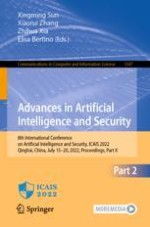2022 | Buch
Advances in Artificial Intelligence and Security
8th International Conference on Artificial Intelligence and Security, ICAIS 2022, Qinghai, China, July 15–20, 2022, Proceedings, Part II
herausgegeben von: Xingming Sun, Prof. Xiaorui Zhang, Zhihua Xia, Prof. Dr. Elisa Bertino
Verlag: Springer International Publishing
Buchreihe : Communications in Computer and Information Science
